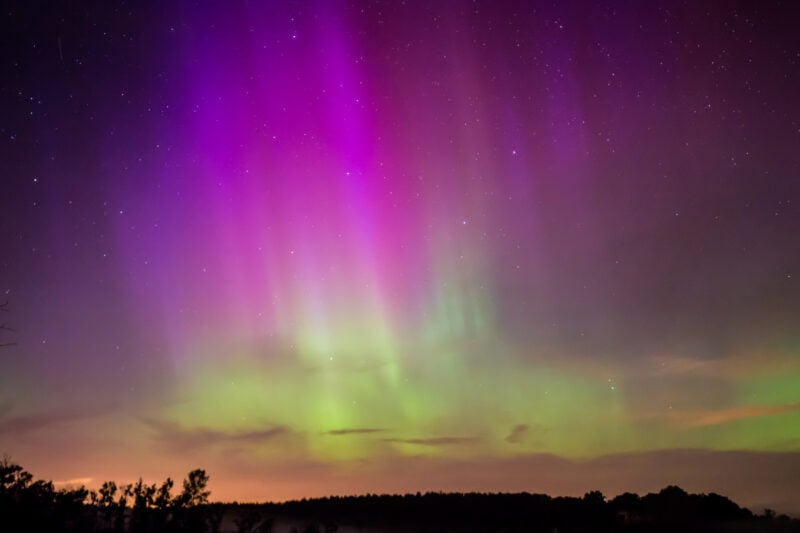TRENTON , NJ – A powerful solar storm sent the Aurora Borealis vivid and far south Tuesday night, with fresh conditions promising another display over North America tonight.
Witnesses across the northern and central United States reported spectacular pink, green and purple curtains of light, reaching as far south as Colorado and Illinois.
According to space-weather authorities, the solar disturbance continues to generate heightened geomagnetic activity and visibility of the aurora is expected to remain elevated Wednesday evening with a peak expected at around midnight.

Key Points
- A G4-level geomagnetic storm triggered by multiple coronal mass ejections from the Sun caused widespread aurora sightings deep into the continental U.S. Tuesday night.
- The forecast for tonight shows the aurora view line pushed into at least 18 U.S. states, meaning clear skies could yield visible auroras across the northern half of the country.
- Observers are urged to go to dark locations away from city lights, face north after sunset, and check for cloud cover if they hope to catch the display.
What happened last night
Monday and Tuesday saw a series of strong solar flares and coronal mass ejections on the Sun that have since collided with Earth’s magnetosphere, producing geomagnetic disturbances registering at G4—the second highest severity level used by the Space Weather Prediction Center.
As a result, auroras spilled over from their normal high-latitude zones and were seen in places not used to such displays. Central Illinois and parts of Colorado reported visible aurora activity for the first time in many years. Photographers documented bright green arcs and vibrant hues toward the northern horizon, with some capturing the spectacle on smartphones and DSLRs alike.
Forecast for tonight and what to watch
The geomagnetic storm conditions are expected to persist into Wednesday night. Forecasters indicate the KP index—a measure of global geomagnetic activity—could reach values in the 6-to-7 range, raising the odds that auroras will be visible at unusually low latitudes.
The latest projections show the southern boundary of potential visibility dipping into the northern tier of U.S. states, meaning that under clear skies, even locations like Michigan, Minnesota, New York, and possibly the northern Midwest could witness the phenomenon.
That said, conditions are never guaranteed—cloud cover, urban light pollution, and local horizon obstructions will impact what can actually be seen. Experts emphasize finding a dark, open site with a view to the north after sunset and letting eyes adjust for the best chance of viewing.
Safety and science behind the spectacle
The aurora occurs when charged particles emitted by the Sun travel toward Earth and interact with our planet’s magnetic field, causing atmospheric gases to glow. While the visual result is dramatic, the underlying space weather disturbance can also influence satellite operations, radio communications, and power systems.
However, for most viewers the main takeaway is the chance to see a rare sky show. With the storm at G4 strength, this is one of the stronger auroral events of the current solar cycle and a prime opportunity for sky watchers.
Sky watchers in New Jesey and across North America who are alert, free of cloud cover, and away from city lights should keep their cameras ready this evening.
